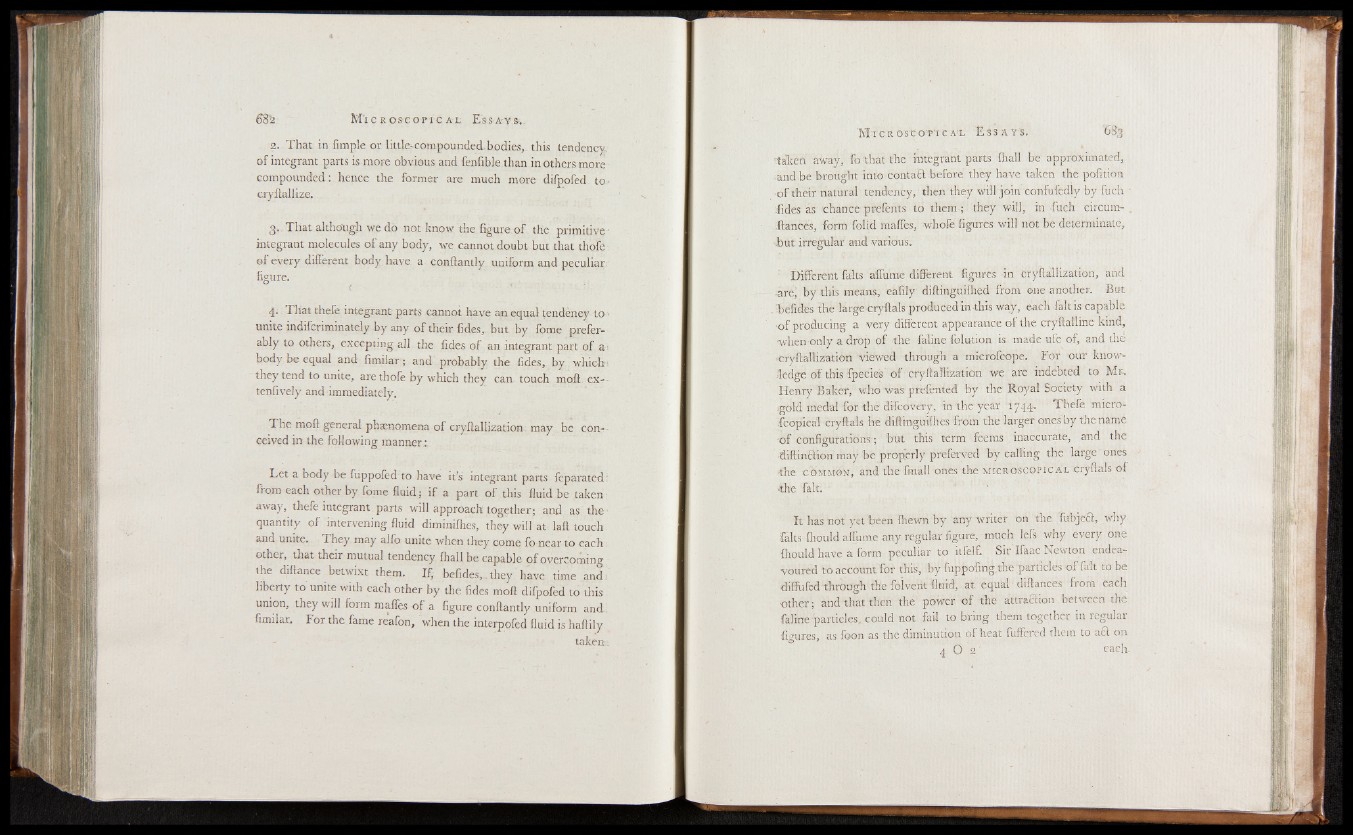
2. That in Ample, or. little-compounded, bodies, this tendency,
of integrant parts is more obvious and fenfible than in others more
compounded: hence the former are much more difpofed to .
cryfkdlize.
3.. That although we do not know the figure o f the primitive *
integrant molecules o f any body, we cannot doubt but that thofe
o f every different body have a conftantly uniform and peculiar,-
figure.
4- That thefe integrant parts cannot have an equal tendency to >
unite indifcriminately by any o f their fides, but by fome preferably
to others, excepting all the fides o f an integrant part of a;
body be equal and fimilar; and probably the fides, by which t
they tend to unite, are thole by which they can touch mod ex--
tenfively and immediately.
The molt general phenomena o f cryftallization: may be conceived
in the following manner.:
Let a body be fuppofed to have it’s integrant parts feparated:
from each other by feme fluid; if a part o f this fluid be taken ■.
away, thefe integrant, parts will approach together; and as the'
quantity o f intervening fluid diminifhes, they will at laft touch
and unite. They may alfo unite when they come fo near to each;
other, that their mutual tendency {hall be capable o f overcoming
the diftance betwixt them. If, befidev. they have time and
liberty to unite with each other by the fides molt difpofed to this
union, they will form maffes o f a figure conftantly uniform and,
fimilar. For the fame reafon, when the interpofed fluid is haftily
taken:
'taken away, fo that the integrant parts ffiall be approximated,
and be brought into contact before they have taken the pofition
•of their natural tendency,’ then they will join confufedly by fuch ■
fides as chance prefents to them; they will, in fuch circum- ,
fiances, form folid maffes, whofe figures will not be determinate,
•hut irregular and various.
Different falls affume different figures in cryftallization, and
•arej by this means, eafity diflinguifhed from one another. But
. heftdes the large Cryftals produced in this way, each fait is capable
•of producing a very different appearance of the cryflatline kind,
-when only a drop of the faline folution is made ufe of, and the
'Cryftallization viewed through a microfcope. For our knowledge
of this fpecies of cryftallization we are indebted to Mr.
Henry Baker, who was prefented by the Royal Society with a
gold medal for the difcovery, in the year ’i 74.4- "Thefe micro-
fcopical cryftals be diftinguifhes from the larger ones'by the name
•of configurations; but this term feems inaccurate, and the
diftinftion may be properly preferved by calling the large ones
•the common, and the final! ones the microscopical cryftals o f
Ahe fait. - ‘
It has not yet been fhewn by any writer on the fubjeft, why
.falls- fhould alfume any regular figure, much lefs why every one
fhould have a form peculiar to itfelfi Sir'Ifaac Newton endeavoured
to account for this, by fuppofing.thc particles of fait to be
diffufed through the folvent fluid, at equal diftances from each
■ other; and that then the power, o f the attraction between the
faline particles, could not fail to bring them together in regular
figures, as foon as the diminution of heat buffered them to a6l on
4 O 2 . . each